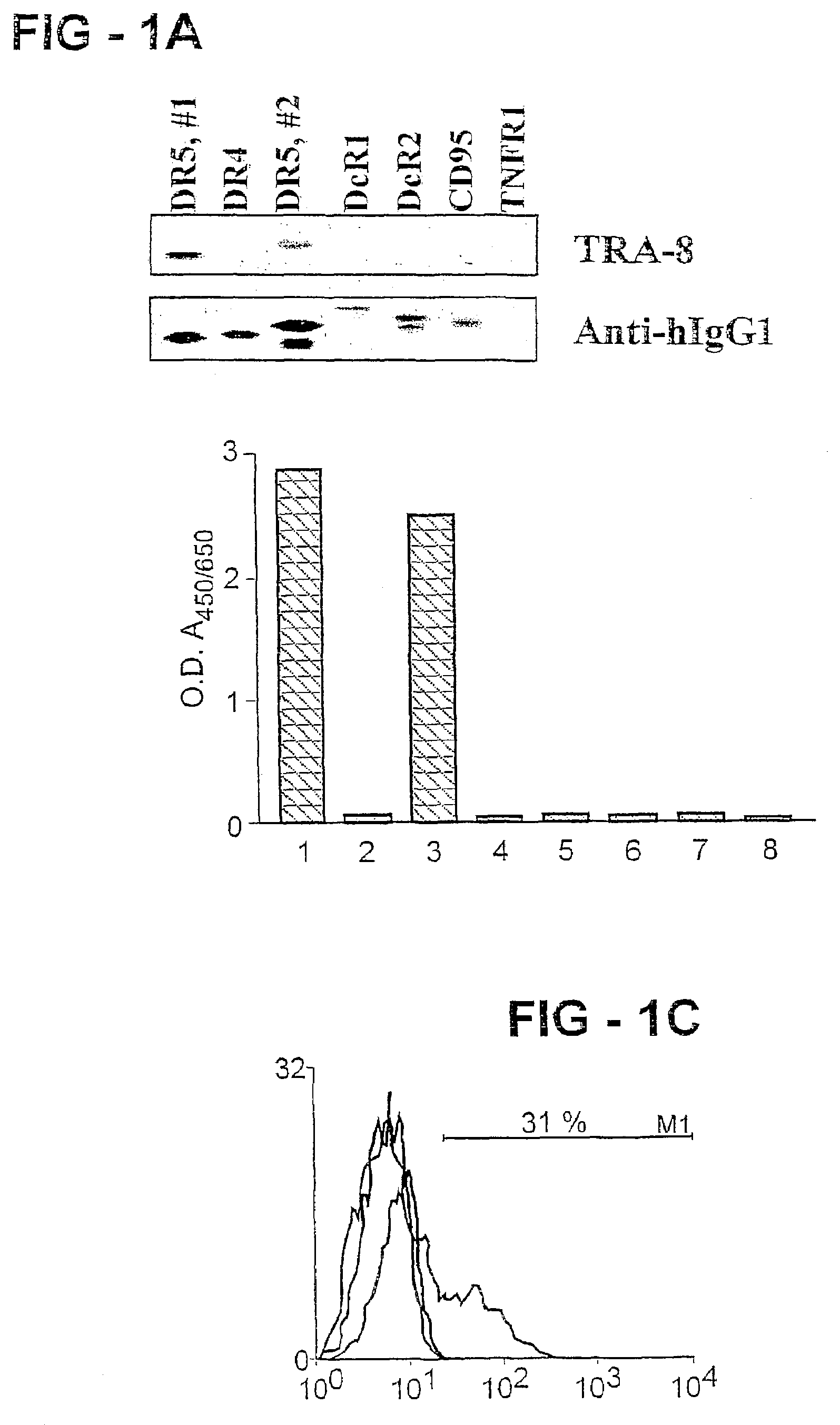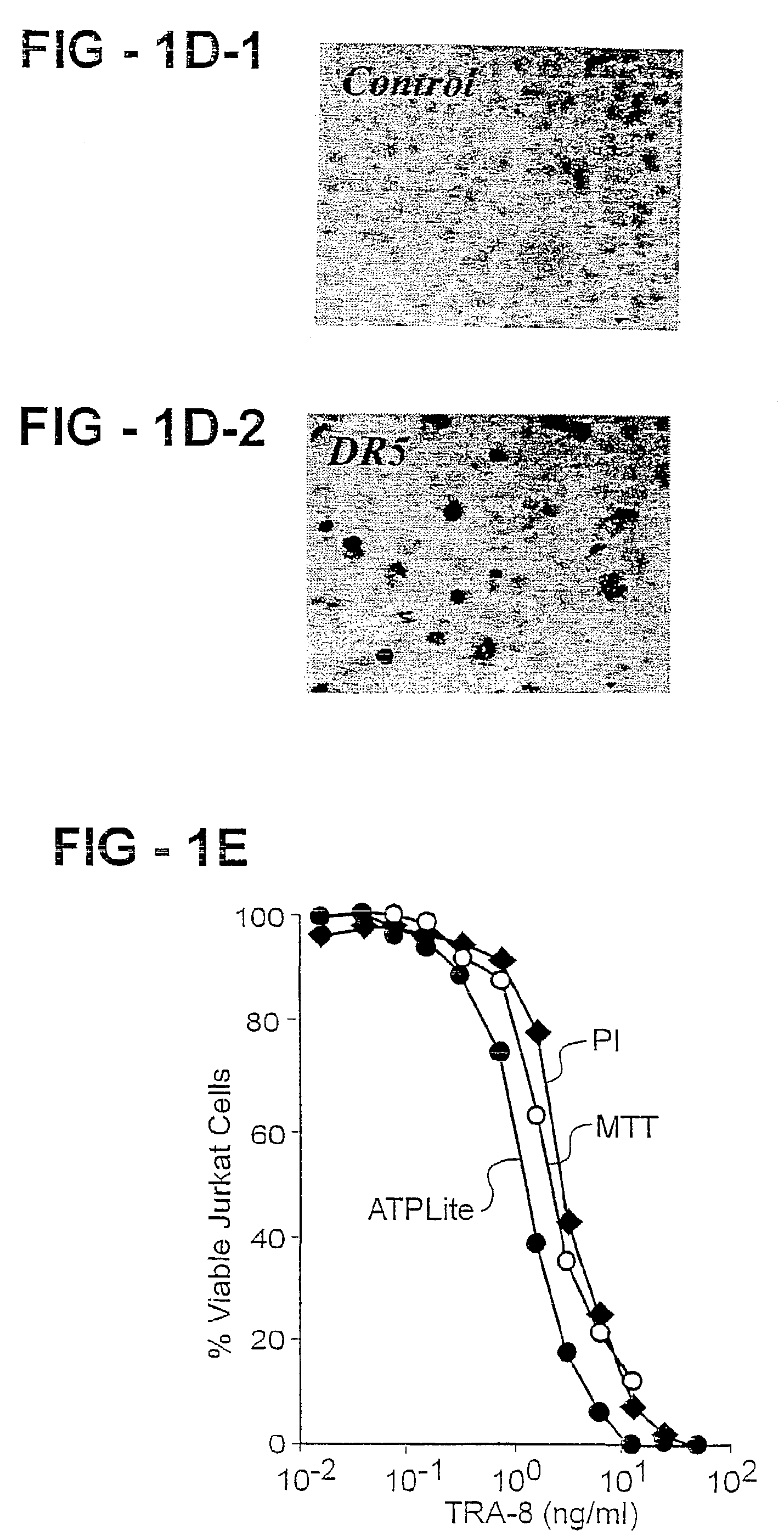Antibody selective for a tumor necrosis factor-related apoptosis-inducing ligand receptor and uses thereof
ligand receptor technology, applied in the field of antibody selective for a tumor necrosis factor-related apoptosis-inducing ligand receptor, can solve the problems of low dr5 monoclonal antibody apoptosis-inducing activity, impeded progress, etc. application of fas ligand-mediated apoptosis as a human therapy,
- Summary
- Abstract
- Description
- Claims
- Application Information
AI Technical Summary
Benefits of technology
Problems solved by technology
Method used
Image
Examples
example 1
Preparation of DR5 Antigen
[0152]1.1 Cloning of DR5 cDNA
[0153]DNA encoding the human DR5 protein is cloned by the following RT-PCR method using:
[0154]a) Template
[0155]The total RNA of HeLa cells is extracted by using TRIzo1 Reagent (GIBCO BRL). The template for the PCR reaction used cDNA that is obtained by using the First-Strand cDNA synthesis kit (Amersham Pharmacia Biotech) according to the instruction manual provided with the kit.
[0156]b) PCR Primers
[0157]The following oligonucleotide primers are synthesized for the PCR:[0158]5′-gacgatgcccgatctactttaaggg-3′ (DR5p1: SEQ ID No. 1);[0159]5-ccactgggtgatgttggatggg-3′ (DR5p2: SEQ ID No. 2);
[0160]Unless otherwise specified, all oligonucleotides in these Examples are synthesized by Lifetechnologies. All oligonucleotides are stored at −20° C. after being dissolved in distilled water.
[0161]c) PCR Reaction
[0162]Composition of the PCR reaction solution:[0163]template cDNA, 5 μl of total 33 μl reaction[0164]primer DR5p 1, 10 pmol;[0165]primer...
example 2
Generation of Monoclonal Antibodies Against Human DR5
[0193]2.1 Immunization
[0194]Female, Balb / c mice (Jackson Laboratory, Bar Harbor, Me.) of 6–8 weeks of age, are immunized with the affinity-purified human DR5 / hIgG1 fusion protein. For the initial foot-pad immunization, the fusion protein (50 μg) is emulsified in Freund's complete adjuvant (Difco, Detroit, Mich.). The mice are then boosted with four injections of 50 μg of fusion protein administered without adjuvant every other day. Three days after the last injection, lymphocytes from the local lymph nodes are fused with NS-1 myeloma cells, and the hybridomas are cultured in F104 media supplemented with 10% fetal calf serum. Positive hybridomas are selected by ELISA in which the plates are coated either with 1 μg / ml DR5 / hIgG1 or the same amount of Fas / hIgG1 as a control. The isotype of the hybridomas is determined by ELISA using a panel of mouse Ig isotype-specific goat antibodies (Southern Biotechnology, Birmingham, Ala.). Monocl...
example 3
Purification of TRA-8 Monoclonal Antibody
[0216]The mouse-mouse hybridoma, TRA-8, is grown to a cell density of 1×106 cells / ml by incubation in 500 ml of ASF medium, containing 10% v / v FCS, at 37° C. under 5% v / v CO2 for 5 days. The culture is then centrifuged (1,000 r.p.m., 5 minutes) and the supernatant collected. The purification of TRA-8 from the supernatant is achieved using ProteinG-Sepharose CL-4B affinity chromatography (Pharmacia) under the following conditions:[0217]column: ProteinG-Sepharose CL-4B column (column size 2 ml; Pharmacia);[0218]elution buffer: 0.1 M Glycine (pH 2.4), 0.15 M NaCl;[0219]neutralization buffer: 1M Tris-HCl (pH 8.5).
[0220]After all of the supernatant is applied to column, 20 ml of PBS is washed three times and then elution buffer is added in 1 ml volumes for 10 times. The optical density of each eluted fraction (1 ml) is measured. The fractions from No. 2 to No. 5 (>OD280=0.1) are collected separately.
[0221]After adding 100 ul of neutralization buff...
PUM
| Property | Measurement | Unit |
|---|---|---|
| concentrations | aaaaa | aaaaa |
| concentrations | aaaaa | aaaaa |
| concentrations | aaaaa | aaaaa |
Abstract
Description
Claims
Application Information
 Login to View More
Login to View More - R&D
- Intellectual Property
- Life Sciences
- Materials
- Tech Scout
- Unparalleled Data Quality
- Higher Quality Content
- 60% Fewer Hallucinations
Browse by: Latest US Patents, China's latest patents, Technical Efficacy Thesaurus, Application Domain, Technology Topic, Popular Technical Reports.
© 2025 PatSnap. All rights reserved.Legal|Privacy policy|Modern Slavery Act Transparency Statement|Sitemap|About US| Contact US: help@patsnap.com



